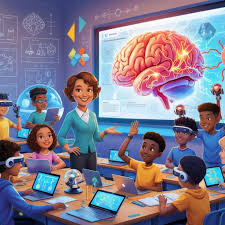Science, technology, engineering, and mathematics education presents unique challenges, requiring abstract concepts to be presented in accessible, engaging formats. The innovative teacher increasingly recognizes the untapped potential of kids animated shows as powerful STEM education tools. These visual narratives transform complex scientific principles into exciting adventures that capture imagination while building foundational understanding of how our world works. This strategic integration of entertainment and education creates memorable learning experiences that resonate long after traditional lessons might be forgotten.
Educational research increasingly supports the effectiveness of narrative-based science communication, particularly for young learners. When STEM concepts appear within compelling storylines featuring relatable characters, children develop emotional connections to the material that enhance retention and motivation. Forward-thinking educators leverage these connections, selecting animated content that accurately presents scientific principles while maintaining the engagement factor that makes these shows appealing to young audiences.
Physics concepts frequently feature in animated programming through exaggerated but fundamentally accurate demonstrations of motion, gravity, and simple machines. While cartoons might amplify these effects for comedic purposes, they often preserve the basic principles at work. Perceptive teachers can use these moments as launching points for classroom discussions and experiments, helping students distinguish between animated hyperbole and the actual scientific principles being illustrated.
Biological sciences receive extensive coverage in many educational animated series, introducing young viewers to ecosystems, animal adaptations, and human body systems through accessible narratives. These programs often incorporate microscopic or internal perspectives impossible to observe directly, helping students visualize abstract biological processes. Teachers can extend this learning through hands-on activities that reinforce the concepts presented in animated form.
Environmental science themes appear consistently in contemporary children’s programming, addressing sustainability, conservation, and ecological relationships. These shows often emphasize humanity’s connection to natural systems and our responsibility toward environmental stewardship. This content naturally complements classroom ecology units, providing narrative contexts that help students understand complex environmental relationships and challenges.
Engineering and design thinking emerges in many animated series featuring characters who invent, build, and problem-solve using technological tools. These programs model the engineering design process—identifying problems, brainstorming solutions, testing prototypes, and refining designs based on results. Teachers can reference these examples when guiding students through their own design challenges, connecting fictional engineering to classroom projects.
Mathematical concepts receive engaging treatment in specialized educational programs that present numerical relationships through visual storytelling. These shows demonstrate practical applications of mathematics in everyday situations, helping students recognize the relevance of abstract concepts. Classroom discussions can explore these connections, reinforcing that mathematical thinking extends far beyond worksheet calculations.
Scientific inquiry skills develop naturally as animated characters model curiosity, observation, hypothesis formation, and experimentation. Many educational programs explicitly showcase the scientific method through character investigations, demonstrating that science represents an active process rather than merely a collection of facts. Teachers can highlight these moments, reinforcing parallel processes in classroom investigations.
Technology literacy features prominently in animated content that depicts characters utilizing various tools to solve problems and access information. While sometimes futuristic, these portrayals familiarize students with technological concepts and digital problem-solving approaches. Classroom discussions can explore both the animated examples and real-world technological applications, building critical awareness of technology’s role in modern society.
Misconception correction represents a valuable opportunity when using animation in STEM education. Teachers can identify common scientific misconceptions portrayed in entertainment-focused programs, using these moments as teaching opportunities rather than reasons to avoid animation entirely. These discussions develop critical thinking about media representations of science while clarifying accurate conceptual understanding.
Implementation strategies determine the educational value of animated content in STEM instruction. Rather than using animation as mere entertainment, effective teachers integrate it purposefully with clear learning objectives. This might involve previewing content, preparing guiding questions, pausing for discussion at key moments, and designing follow-up investigations that extend learning beyond passive viewing experiences.
Assessment considerations should acknowledge both content knowledge and scientific thinking skills developed through engaging with animated STEM content. Beyond factual recall, teachers might evaluate students’ ability to apply concepts to new situations, identify scientific principles in media, design investigations inspired by animated scenarios, or critically evaluate the scientific accuracy of various programs. This comprehensive approach recognizes the complex nature of scientific literacy.
Parent-teacher partnerships enhance learning when educators communicate about classroom media use and suggest quality STEM-focused programming for home viewing. This collaboration creates continuity between school and family learning environments, extending opportunities for scientific discussions beyond school hours. Many educational programs now include parent resources specifically designed to support these connections.
Professional development increasingly includes training on integrating media literacy with STEM education. Teachers learn to evaluate animated content for scientific accuracy, age-appropriateness, and alignment with curriculum standards. This critical assessment helps educators make informed choices about which programs truly support their teaching goals rather than simply entertaining students without educational substance.
In conclusion, thoughtfully selected animated programming offers valuable resources for STEM education that complement traditional teaching approaches. By explicitly connecting entertaining narratives to scientific concepts and inquiry processes, educators create engaging learning experiences that build both knowledge and enthusiasm for STEM fields. As science education continues evolving to address complex contemporary challenges, the strategic integration of quality animated content represents a promising approach for developing scientifically literate citizens prepared for an increasingly technological future.

